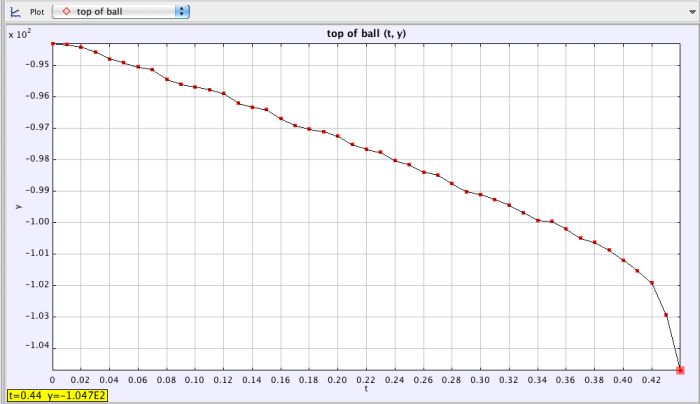A Little More Slinky Goodness
Back to the slinky drop. The last of the Veritasium videos shows a slinky with a ball attached to the end being dropped (as opposed to the slinky stretched only by it’s own mass). This particular video is here.
The ball-on-slinky video appears to show the ball moving downward almost immediately, as opposed to the slinky-alone situation, where the lower coils do not move until the slinky has collapsed upon itself. In the comments to the Dot Physics blog where Rhett Allain has posted a computational model of the slinky drop, it is suggested that the mass of the ball shifts the center of mass lower in the slinky-ball system, thus making the lower end of the system move sooner. This puzzled me, because the ball seemed to move right away.
Since my students were busy learning how to use Tracker to do video analysis on the slinky-alone situation, I dove into looking at what was going on with the ball-on-slinky situation. The video that Derek had sent me was 300 fps, and I looked at every third frame (every 0.01 s), since I was unsuccessful in getting the autotracker feature to work on the top of the slinky. The slinky is dropped very quickly after the high speed video starts, so I started my analysis on the very first frame. The vertical position of the top edge of the tennis ball with respect to time is shown below (autotracker worked great on this… yay!)
As you can see, the ball is moving by 0.02 s after the start of the video. This is the seventh frame of the video. Interestingly, the ball falls with a constant velocity, indicating zero net force. Hmm. So I looked at the top of the slinky to see when it was released. This was hard. Rod Cross’s fingers obscure the top of the slinky, so I tried to track his pinky (the finger closest to the camera) and see when it moved. The result of manual frame-by-frame point selection is below:
 Now I think that shift at 0.01 s is due to the limits of my ability to click in the same place on the video when selecting points. At any rate, nothing much happens until after 0.06 s. But let’s see, even if the top of the slinky is initially obscured by fingers, maybe we can get some kind of information from tracking the top edge of the slinky as soon as we can see it. Here’s the data.
Now I think that shift at 0.01 s is due to the limits of my ability to click in the same place on the video when selecting points. At any rate, nothing much happens until after 0.06 s. But let’s see, even if the top of the slinky is initially obscured by fingers, maybe we can get some kind of information from tracking the top edge of the slinky as soon as we can see it. Here’s the data.
 Now I can’t really see the top of the slinky until about 0.09 s. But I feel good about my ability to track the top of the slinky after that. Note that the slinky is still speeding up until 0.012 s. And the position at 0.09 s is pretty close to where I would suspect Rod’s fingers are gripping the top coil, given the shape of his hands in the video. So it appears that the slinky is definitely not released until somewhere after 0.06s.
Now I can’t really see the top of the slinky until about 0.09 s. But I feel good about my ability to track the top of the slinky after that. Note that the slinky is still speeding up until 0.012 s. And the position at 0.09 s is pretty close to where I would suspect Rod’s fingers are gripping the top coil, given the shape of his hands in the video. So it appears that the slinky is definitely not released until somewhere after 0.06s.
Note that by this time (0.06s), the ball at the bottom of the slinky is already moving at a constant velocity! When the top of the slinky is finally released, the entire system is moving downward at a constant velocity. Rod must have shifted his hands at the very last moment (or the last 0.05 s) before releasing the top coil. Or maybe the ball was in the middle of a bounce when it was released (I wish the video had started about 0.1 s earlier!). By the way, 0.42 s is about where the slinky is fully compressed. Note the beginning of non-zero downward acceleration of the ball at that point.
The constant downward velocity of ball before the slinky is released, and its continuing constant velocity of approximately the same magnitude after release, make me think that this velocity is not due to the release at all. If Rod Cross had been able to hold everything stock still before release, I think we would see the ball stay at rest for awhile. What do you think? Have I missed something?

Leave a comment